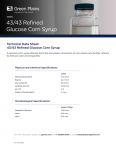Sorghum flour for economical gluten-free nutrition
Sorghum is one of the world’s oldest known grains, and varies in color from dark brown, to red, to white. It is also one of a range of ancient grains that are naturally gluten-free that have gained in popularity as the market for gluten-free foods has grown. Others include amaranth, teff, millet, and quinoa.
According to a Datamonitor report, entitled The Future of Gluten-Free: Consumer Insight and Product Opportunities, the global market for gluten-free products is expected to reach more than $4.3bn within the next five years, representing growth of $1.2bn.
ADM technical products and market development manager Brook Carson said: “With sorghum flour, we can offer customers a gluten-free solution that is more economical than most specialty flours.”
Despite the popularity of gluten-free foods, there has been some concern about their nutritional value, as some gluten-free manufacturers have concentrated on rice, corn and potato flour with xanthan or guar gum added to improve texture, often providing sub-optimal levels of essential nutrients.
And this is where flours from ancient grains – like sorghum – have attracted product developers.
ADM said that different types of sorghum flour provide different benefits to manufacturers depending on the intended application. White sorghum flour, for instance, provides a bland flavor, which can be useful for reproducing the flavor of white wheat flour without any unfamiliar or distinctive tastes. Meanwhile, whole grain white sorghum flour can be used to produce a gluten-free product that also has the nutritional benefits associated with whole grains.
Sufferers of celiac disease have to avoid all gluten in their diet, but increased diagnosis is not the only factor behind gluten-free market expansion. A growing sector of the population are self-diagnosing wheat or gluten intolerance, and an additional group believes that avoiding gluten is a healthier way of eating, also a key driver of the gluten-free market.













